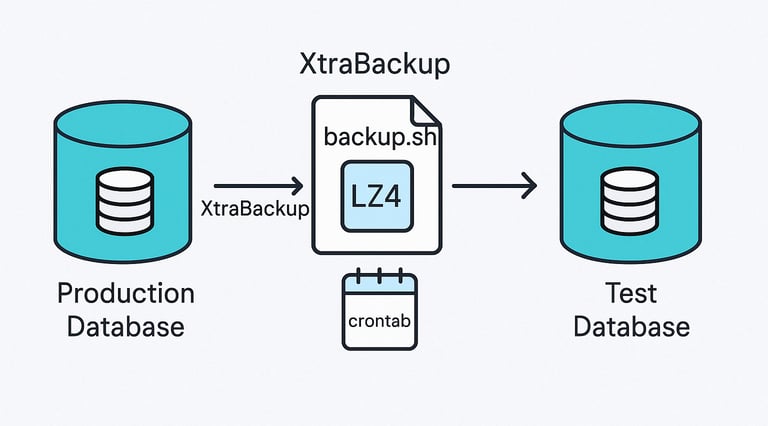Automated Percona Backups with XtraBackup – Simple Script Guide
DATABASEPERCONA
ITQuickFix
4/19/20252 min read
In this guide, we’ll walk through the process of automating hot, full backups from a production Percona database and restoring them onto a test server. The goal is to regularly back up data from production and replicate it in testing environments for development or validation purposes.
Both servers run:
Operating System: Rocky Linux 9
Database Engine: Percona Server 8.4
Backup Tool: Percona XtraBackup 8.4
Environment Setup
Servers
Production Server: Percona 8.4 on Rocky Linux 9
Test Server: Percona 8.4 on Rocky Linux 9
Required Variables
# Access credentials
HOST="your_production_db_ip_or_hostname"
PORT="3306"
USER="your_username"
PASS="your_password"
# Directories
BACKUP_DIR="/backup/xtrabck/"
DATA_DIR="/var/lib/mysql"
# Timestamp
START=$(date +"%m-%d-%Y %H:%M:%S")
END=$(date +"%m-%d-%Y %H:%M:%S")
In our case:
We have a dedicated 200 GB disk mounted at /backup.
The Percona data directory is located at /var/lib/mysql.
Clean the Backup Directory
Before starting a new backup, ensure that the backup directory is clean to avoid consuming unnecessary disk space:
CLEAN=$(du -sh /backup/xtrabck | cut -f1)
if [ ! -d $BACKUP_DIR ]; then
mkdir -p $BACKUP_DIR
fi
rm -rf $BACKUP_DIR/*
echo "$(date '+%Y-%m-%d %H:%M:%S:%s') : Cleanup the backup folder is done! Starting backup" >> $BACKUP_DIR/xtrabackup.log
Performing the Hot Backup
Now, perform the actual hot backup using LZ4 compression and parallel threads to speed up the process:
xtrabackup --backup \
--datadir=$DATA_DIR \
--target-dir=$BACKUP_DIR \
--user="$USER" \
--password="$PASS" \
--no-timestamp \
--compress=LZ4 \
--compress-threads=4
echo "$(date '+%Y-%m-%d %H:%M:%S:%s') : Backup Done!" >> $BACKUP_DIR/xtrabackup.log
Hiding Credentials (Optional)
To avoid hardcoding credentials in the script, you can use the MySQL configuration file /etc/my.cnf:
[xtrabackup]
user=your_username
password=your_password
Once the credentials are stored there, you can remove --user and --password from the xtrabackup command.
Make sure to secure the file:
chmod 600 /etc/my.cnf
Complete Backup Script
Here’s the full script, combining all of the above:
#!/bin/bash
# Database access
HOST='your_production_db_ip_or_hostname'
PORT='3306'
USER='your_username'
PASS='your_password'
# Directories
BACKUP_DIR="/backup/xtrabck/"
DATA_DIR="/var/lib/mysql"
# Timestamp
START=$(date +"%m-%d-%Y %H:%M:%S")
END=$(date +"%m-%d-%Y %H:%M:%S")
# Clean old backups
CLEAN=$(du -sh /backup/xtrabck | cut -f1)
if [ ! -d $BACKUP_DIR ]; then
mkdir -p $BACKUP_DIR
fi
rm -rf $BACKUP_DIR/*
echo "$(date '+%Y-%m-%d %H:%M:%S:%s') : Cleanup the backup folder is done! Starting backup" >> $BACKUP_DIR/xtrabackup.log
# Perform hot backup with compression
xtrabackup --backup \
--datadir=$DATA_DIR \
--target-dir=$BACKUP_DIR \
--user="$USER" \
--password="$PASS" \
--no-timestamp \
--compress=LZ4 \
--compress-threads=4
echo "$(date '+%Y-%m-%d %H:%M:%S:%s') : Backup Done!" >> $BACKUP_DIR/xtrabackup.log
exit
Automation with Cron
To run this backup daily at midnight, add the following entry to your crontab:
0 0 * * * /path/to/your/backup.sh
Final Notes
Make sure /backup/ has sufficient space and proper mount options.
Ensure the script has execution permissions: chmod +x /path/to/backup.sh.
You may want to set up email alerts or logs rotation depending on your environment.


Get expert solutions for your IT challenges today.
© 2025. All rights reserved.


